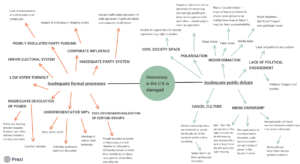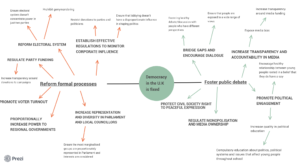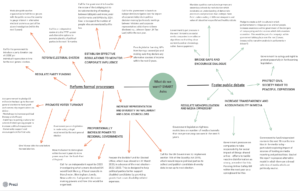
By Iona Cable
The world of advocacy and campaigning can seem like a daunting and complicated place, where conversations either take place in the dim corridors of government or on the bright streets with loud banners and chants. But every campaign that you’ve seen starts with an idea, a problem that a person or group of people knew that they could make a difference about. At Future Advocacy, we’ve spent a lot of time working with a range of organisations to pinpoint problems and equip them with the skills needed to effectively campaign on the issue. Last month, we decided that it was our turn, and embarked on a project of our own to tackle an issue which we felt required some attention. The issue? British democracy.
The US-led Summit for Democracy is a 2-day event which started just yesterday, the 9th December. It is an opportunity for world leaders to put their words at the G7 summit into action, with each country required to make new international and domestic commitments to “reduce corruption, defend against authoritarianism and protect human rights.” This is an important endeavour for the British government, particularly since CIVICUS, the global civil society alliance committed to strengthening democracy, highlighted a decline in the exercise of civil freedoms in the UK in September of this year. We believe that a non-partisan, cross-party approach to strengthening British democracy is key to ensure a lasting impact.
It’s worth saying from the outset that, as an organisation, we are not experts on democracy. Our expertise is in high impact advocacy, research and communications, which means that we design campaigns to make the world a better place while working closely with organisations which are specialists in these issues. So if there are any democracy experts reading this who want to get involved in an exciting campaign, please do get in touch!
What’s the problem?
We quickly realised that stating the problem of ‘British democracy’ was slightly too broad to launch a successful advocacy campaign from. So, we began to map our ‘problem tree’, where we spit-balled our thoughts on what was wrong with democracy in the UK today, where we found that the issues fell into 2 categories. The first was inadequate public debate, which covered a broad swath of issues ranging from polarisation and misinformation as a result of both mainstream and social media, to a lack of political engagement stemming from inadequate and insufficient political education and a sense of apathy and helplessness. The second encompassed more formal political processes, including low voter turnout, corporate influence, an inadequate party system and poorly regulated party funding. Nothing major then.

Flip it
After splurging everything we thought was wrong with democracy today (quite therapeutic, really) we moved on to our ‘solution tree’. This is literally just taking a point from your problem tree and writing it’s antithesis. For example, people on either end of the political spectrum are becoming increasingly unwilling to listen and cooperate with each other becomes ensure that people are exposed to a wide range of views. This may feel like a pointless and simplistic exercise, with no thought into how you might achieve that, but it forced us to think about what exactly it is we want. We found that the ability to reimagine the world the way you want it to be is at the heart of campaigning.

What do we want?
Now that we had a tree of all of the solutions to our problems, we turned those solutions into SMART asks:
Specific
Measurable
Attributable
Relevant
Timebound
It’s useful to think about who these asks are directed towards, and this can range from the government, to businesses, to broader societal changes.
To return to our example used above about ensuring that people are exposed to a wide range of viewpoints, we had to think about why this isn’t the case at the moment. We discussed the impact of social media, creating echo chambers for people online where they view content which reflects their own interests and perspectives. After doing some further reading around this issue, we found that algorithms are designed to show content based on engagement – to keep you hooked on your Instagram feed, the app is designed to promote content that it thinks you might be interested in, based on your earlier interactions. When it comes to political discourse, this means that you are exposed to views that the algorithm believes you would be interested in hearing, which typically align with the views you already hold.
So, our solution to this problem that we identified called for the government to put pressure on social media companies in the next 18 months to recalibrate their algorithms so that they show content based on chronology, rather than engagement. This is a massive over-simplification of a really complex process, and in practice our solution may not hold up under scrutiny (not least because a chronological newsfeed would be really boring) but you can see the process of how our really vague problem about polarisation became a specific, measurable, achievable, relevant and timebound ask for our campaign.

Through these 3 steps, we’ve identified the problems that we feel passionately about, the solutions to these (thinking about the world that we want to see), and the asks that would help us to achieve these solutions. We have the basic foundations of a campaign! But this is only the beginning – throughout the process, we repeatedly referred back to our graphics to make sure that we focused on what was most important. Next steps will involve prioritising these asks to pick one that we want to focus on, and mapping out the key stakeholders in this campaign. We’d love any feedback that you have on the beginnings of our project, and what you think are the major problems with democracy in the UK today (or if you even think there are any at all!) so please do get in touch.